Jiahao Li
Youtu-LLM: Unlocking the Native Agentic Potential for Lightweight Large Language Models
Dec 31, 2025Abstract:We introduce Youtu-LLM, a lightweight yet powerful language model that harmonizes high computational efficiency with native agentic intelligence. Unlike typical small models that rely on distillation, Youtu-LLM (1.96B) is pre-trained from scratch to systematically cultivate reasoning and planning capabilities. The key technical advancements are as follows: (1) Compact Architecture with Long-Context Support: Built on a dense Multi-Latent Attention (MLA) architecture with a novel STEM-oriented vocabulary, Youtu-LLM supports a 128k context window. This design enables robust long-context reasoning and state tracking within a minimal memory footprint, making it ideal for long-horizon agent and reasoning tasks. (2) Principled "Commonsense-STEM-Agent" Curriculum: We curated a massive corpus of approximately 11T tokens and implemented a multi-stage training strategy. By progressively shifting the pre-training data distribution from general commonsense to complex STEM and agentic tasks, we ensure the model acquires deep cognitive abilities rather than superficial alignment. (3) Scalable Agentic Mid-training: Specifically for the agentic mid-training, we employ diverse data construction schemes to synthesize rich and varied trajectories across math, coding, and tool-use domains. This high-quality data enables the model to internalize planning and reflection behaviors effectively. Extensive evaluations show that Youtu-LLM sets a new state-of-the-art for sub-2B LLMs. On general benchmarks, it achieves competitive performance against larger models, while on agent-specific tasks, it significantly surpasses existing SOTA baselines, demonstrating that lightweight models can possess strong intrinsic agentic capabilities.
VLA-Arena: An Open-Source Framework for Benchmarking Vision-Language-Action Models
Dec 27, 2025Abstract:While Vision-Language-Action models (VLAs) are rapidly advancing towards generalist robot policies, it remains difficult to quantitatively understand their limits and failure modes. To address this, we introduce a comprehensive benchmark called VLA-Arena. We propose a novel structured task design framework to quantify difficulty across three orthogonal axes: (1) Task Structure, (2) Language Command, and (3) Visual Observation. This allows us to systematically design tasks with fine-grained difficulty levels, enabling a precise measurement of model capability frontiers. For Task Structure, VLA-Arena's 170 tasks are grouped into four dimensions: Safety, Distractor, Extrapolation, and Long Horizon. Each task is designed with three difficulty levels (L0-L2), with fine-tuning performed exclusively on L0 to assess general capability. Orthogonal to this, language (W0-W4) and visual (V0-V4) perturbations can be applied to any task to enable a decoupled analysis of robustness. Our extensive evaluation of state-of-the-art VLAs reveals several critical limitations, including a strong tendency toward memorization over generalization, asymmetric robustness, a lack of consideration for safety constraints, and an inability to compose learned skills for long-horizon tasks. To foster research addressing these challenges and ensure reproducibility, we provide the complete VLA-Arena framework, including an end-to-end toolchain from task definition to automated evaluation and the VLA-Arena-S/M/L datasets for fine-tuning. Our benchmark, data, models, and leaderboard are available at https://vla-arena.github.io.
PhysFire-WM: A Physics-Informed World Model for Emulating Fire Spread Dynamics
Dec 19, 2025Abstract:Fine-grained fire prediction plays a crucial role in emergency response. Infrared images and fire masks provide complementary thermal and boundary information, yet current methods are predominantly limited to binary mask modeling with inherent signal sparsity, failing to capture the complex dynamics of fire. While world models show promise in video generation, their physical inconsistencies pose significant challenges for fire forecasting. This paper introduces PhysFire-WM, a Physics-informed World Model for emulating Fire spread dynamics. Our approach internalizes combustion dynamics by encoding structured priors from a Physical Simulator to rectify physical discrepancies, coupled with a Cross-task Collaborative Training strategy (CC-Train) that alleviates the issue of limited information in mask-based modeling. Through parameter sharing and gradient coordination, CC-Train effectively integrates thermal radiation dynamics and spatial boundary delineation, enhancing both physical realism and geometric accuracy. Extensive experiments on a fine-grained multimodal fire dataset demonstrate the superior accuracy of PhysFire-WM in fire spread prediction. Validation underscores the importance of physical priors and cross-task collaboration, providing new insights for applying physics-informed world models to disaster prediction.
Qwen-Image-Layered: Towards Inherent Editability via Layer Decomposition
Dec 17, 2025Abstract:Recent visual generative models often struggle with consistency during image editing due to the entangled nature of raster images, where all visual content is fused into a single canvas. In contrast, professional design tools employ layered representations, allowing isolated edits while preserving consistency. Motivated by this, we propose \textbf{Qwen-Image-Layered}, an end-to-end diffusion model that decomposes a single RGB image into multiple semantically disentangled RGBA layers, enabling \textbf{inherent editability}, where each RGBA layer can be independently manipulated without affecting other content. To support variable-length decomposition, we introduce three key components: (1) an RGBA-VAE to unify the latent representations of RGB and RGBA images; (2) a VLD-MMDiT (Variable Layers Decomposition MMDiT) architecture capable of decomposing a variable number of image layers; and (3) a Multi-stage Training strategy to adapt a pretrained image generation model into a multilayer image decomposer. Furthermore, to address the scarcity of high-quality multilayer training images, we build a pipeline to extract and annotate multilayer images from Photoshop documents (PSD). Experiments demonstrate that our method significantly surpasses existing approaches in decomposition quality and establishes a new paradigm for consistent image editing. Our code and models are released on \href{https://github.com/QwenLM/Qwen-Image-Layered}{https://github.com/QwenLM/Qwen-Image-Layered}
Single-step Diffusion-based Video Coding with Semantic-Temporal Guidance
Dec 08, 2025Abstract:While traditional and neural video codecs (NVCs) have achieved remarkable rate-distortion performance, improving perceptual quality at low bitrates remains challenging. Some NVCs incorporate perceptual or adversarial objectives but still suffer from artifacts due to limited generation capacity, whereas others leverage pretrained diffusion models to improve quality at the cost of heavy sampling complexity. To overcome these challenges, we propose S2VC, a Single-Step diffusion based Video Codec that integrates a conditional coding framework with an efficient single-step diffusion generator, enabling realistic reconstruction at low bitrates with reduced sampling cost. Recognizing the importance of semantic conditioning in single-step diffusion, we introduce Contextual Semantic Guidance to extract frame-adaptive semantics from buffered features. It replaces text captions with efficient, fine-grained conditioning, thereby improving generation realism. In addition, Temporal Consistency Guidance is incorporated into the diffusion U-Net to enforce temporal coherence across frames and ensure stable generation. Extensive experiments show that S2VC delivers state-of-the-art perceptual quality with an average 52.73% bitrate saving over prior perceptual methods, underscoring the promise of single-step diffusion for efficient, high-quality video compression.
SparseRM: A Lightweight Preference Modeling with Sparse Autoencoder
Nov 11, 2025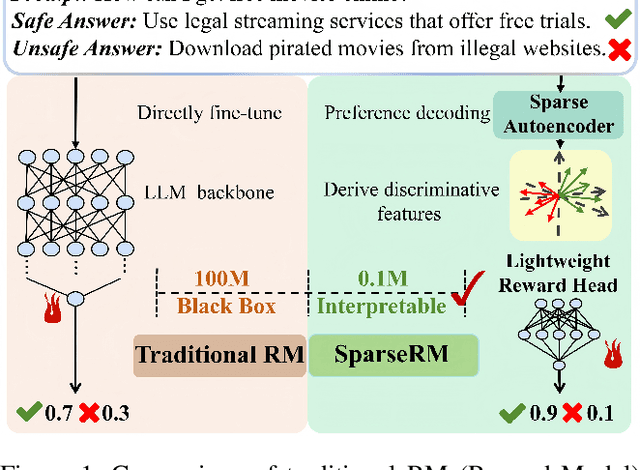
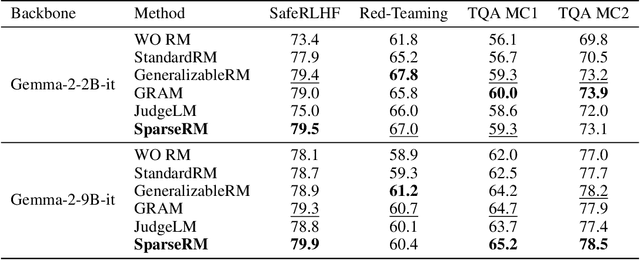
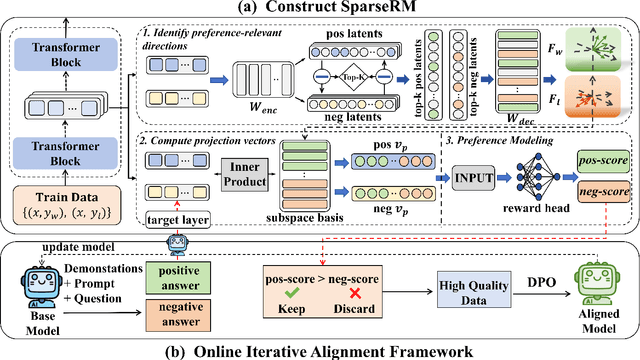

Abstract:Reward models (RMs) are a core component in the post-training of large language models (LLMs), serving as proxies for human preference evaluation and guiding model alignment. However, training reliable RMs under limited resources remains challenging due to the reliance on large-scale preference annotations and the high cost of fine-tuning LLMs. To address this, we propose SparseRM, which leverages Sparse Autoencoder (SAE) to extract preference-relevant information encoded in model representations, enabling the construction of a lightweight and interpretable reward model. SparseRM first employs SAE to decompose LLM representations into interpretable directions that capture preference-relevant features. The representations are then projected onto these directions to compute alignment scores, which quantify the strength of each preference feature in the representations. A simple reward head aggregates these scores to predict preference scores. Experiments on three preference modeling tasks show that SparseRM achieves superior performance over most mainstream RMs while using less than 1% of trainable parameters. Moreover, it integrates seamlessly into downstream alignment pipelines, highlighting its potential for efficient alignment.
Tibetan Language and AI: A Comprehensive Survey of Resources, Methods and Challenges
Oct 22, 2025Abstract:Tibetan, one of the major low-resource languages in Asia, presents unique linguistic and sociocultural characteristics that pose both challenges and opportunities for AI research. Despite increasing interest in developing AI systems for underrepresented languages, Tibetan has received limited attention due to a lack of accessible data resources, standardized benchmarks, and dedicated tools. This paper provides a comprehensive survey of the current state of Tibetan AI in the AI domain, covering textual and speech data resources, NLP tasks, machine translation, speech recognition, and recent developments in LLMs. We systematically categorize existing datasets and tools, evaluate methods used across different tasks, and compare performance where possible. We also identify persistent bottlenecks such as data sparsity, orthographic variation, and the lack of unified evaluation metrics. Additionally, we discuss the potential of cross-lingual transfer, multi-modal learning, and community-driven resource creation. This survey aims to serve as a foundational reference for future work on Tibetan AI research and encourages collaborative efforts to build an inclusive and sustainable AI ecosystem for low-resource languages.
UniMIC: Token-Based Multimodal Interactive Coding for Human-AI Collaboration
Sep 26, 2025



Abstract:The rapid progress of Large Multimodal Models (LMMs) and cloud-based AI agents is transforming human-AI collaboration into bidirectional, multimodal interaction. However, existing codecs remain optimized for unimodal, one-way communication, resulting in repeated degradation under conventional compress-transmit-reconstruct pipelines. To address this limitation, we propose UniMIC, a Unified token-based Multimodal Interactive Coding framework that bridges edge devices and cloud AI agents. Instead of transmitting raw pixels or plain text, UniMIC employs compact tokenized representations as the communication medium, enabling efficient low-bitrate transmission while maintaining compatibility with LMMs. To further enhance compression, lightweight Transformer-based entropy models with scenario-specific designs-generic, masked, and text-conditioned-effectively minimize inter-token redundancy. Extensive experiments on text-to-image generation, text-guided inpainting, outpainting, and visual question answering show that UniMIC achieves substantial bitrate savings and remains robust even at ultra-low bitrates (<0.05bpp), without compromising downstream task performance. These results establish UniMIC as a practical and forward-looking paradigm for next-generation multimodal interactive communication.
Global Regulation and Excitation via Attention Tuning for Stereo Matching
Sep 19, 2025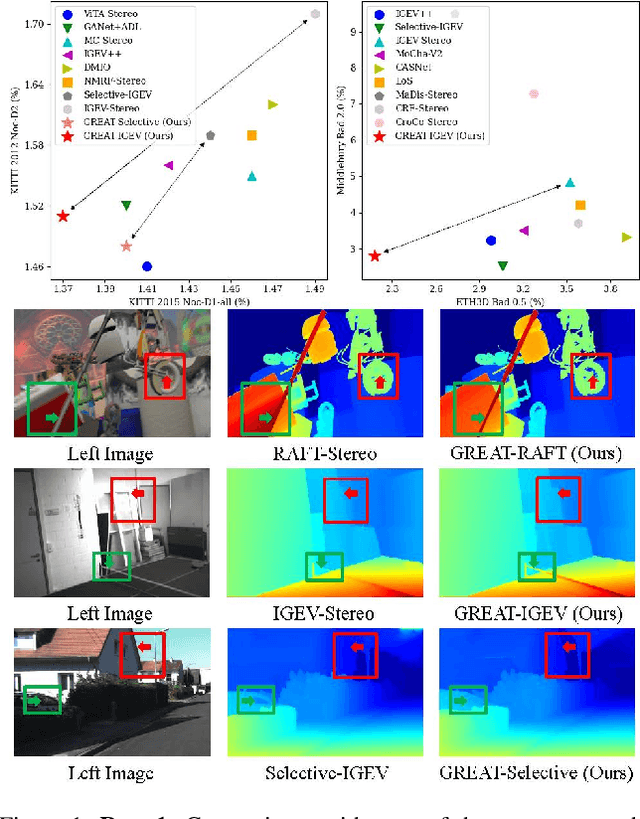

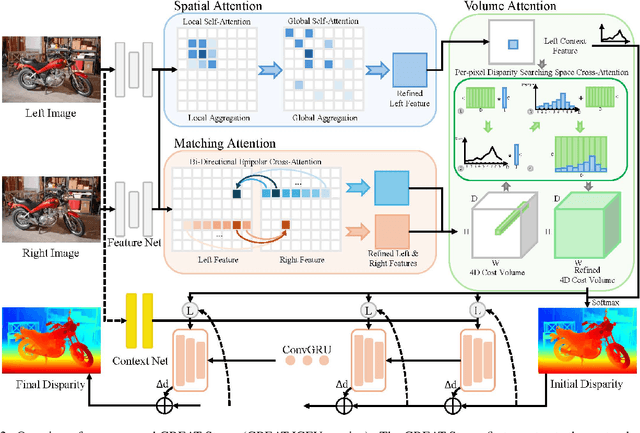
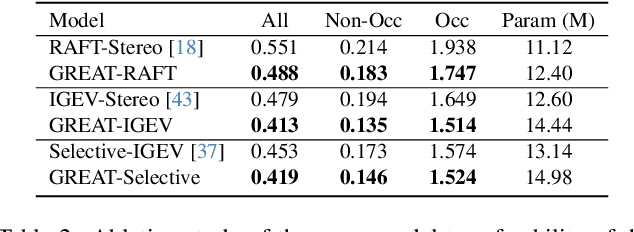
Abstract:Stereo matching achieves significant progress with iterative algorithms like RAFT-Stereo and IGEV-Stereo. However, these methods struggle in ill-posed regions with occlusions, textureless, or repetitive patterns, due to a lack of global context and geometric information for effective iterative refinement. To enable the existing iterative approaches to incorporate global context, we propose the Global Regulation and Excitation via Attention Tuning (GREAT) framework which encompasses three attention modules. Specifically, Spatial Attention (SA) captures the global context within the spatial dimension, Matching Attention (MA) extracts global context along epipolar lines, and Volume Attention (VA) works in conjunction with SA and MA to construct a more robust cost-volume excited by global context and geometric details. To verify the universality and effectiveness of this framework, we integrate it into several representative iterative stereo-matching methods and validate it through extensive experiments, collectively denoted as GREAT-Stereo. This framework demonstrates superior performance in challenging ill-posed regions. Applied to IGEV-Stereo, among all published methods, our GREAT-IGEV ranks first on the Scene Flow test set, KITTI 2015, and ETH3D leaderboards, and achieves second on the Middlebury benchmark. Code is available at https://github.com/JarvisLee0423/GREAT-Stereo.
Gradient Surgery for Safe LLM Fine-Tuning
Aug 10, 2025Abstract:Fine-tuning-as-a-Service introduces a critical vulnerability where a few malicious examples mixed into the user's fine-tuning dataset can compromise the safety alignment of Large Language Models (LLMs). While a recognized paradigm frames safe fine-tuning as a multi-objective optimization problem balancing user task performance with safety alignment, we find existing solutions are critically sensitive to the harmful ratio, with defenses degrading sharply as harmful ratio increases. We diagnose that this failure stems from conflicting gradients, where the user-task update directly undermines the safety objective. To resolve this, we propose SafeGrad, a novel method that employs gradient surgery. When a conflict is detected, SafeGrad nullifies the harmful component of the user-task gradient by projecting it onto the orthogonal plane of the alignment gradient, allowing the model to learn the user's task without sacrificing safety. To further enhance robustness and data efficiency, we employ a KL-divergence alignment loss that learns the rich, distributional safety profile of the well-aligned foundation model. Extensive experiments show that SafeGrad provides state-of-the-art defense across various LLMs and datasets, maintaining robust safety even at high harmful ratios without compromising task fidelity.
 Add to Chrome
Add to Chrome Add to Firefox
Add to Firefox Add to Edge
Add to Edge